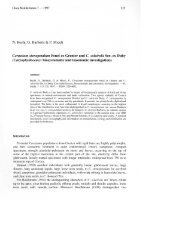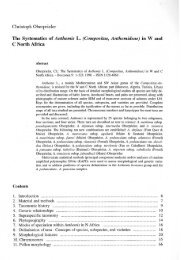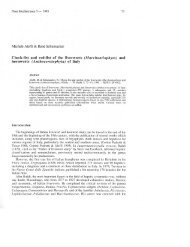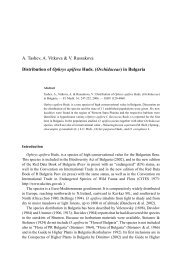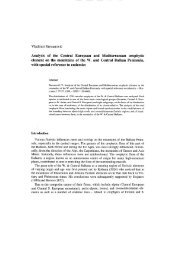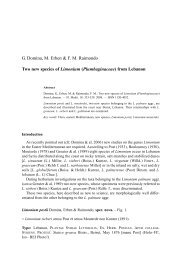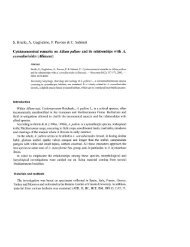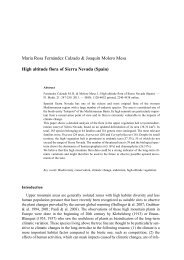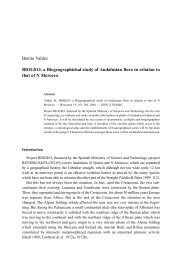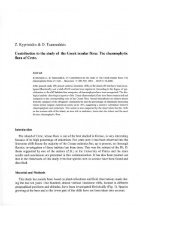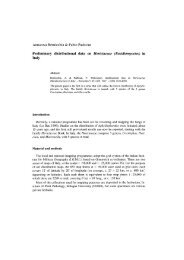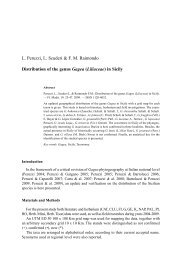Armillaria cepistipes and A. gallica (Agaricales ... - Herbmedit.org
Armillaria cepistipes and A. gallica (Agaricales ... - Herbmedit.org
Armillaria cepistipes and A. gallica (Agaricales ... - Herbmedit.org
You also want an ePaper? Increase the reach of your titles
YUMPU automatically turns print PDFs into web optimized ePapers that Google loves.
864 Intini: <strong>Armillaria</strong> in Italy<br />
the ontogeny of the fruiting bodies, starting from their earliest stages of growth. All descriptions<br />
were made on the basis of fresh specimens that had developed under normal<br />
conditions.<br />
Mycelia of the two species that had been produced in culture, designated with the initials<br />
AB-PT <strong>and</strong> IN-MA, respectively, were sent to institutes at Clermont-Ferr<strong>and</strong> <strong>and</strong><br />
Zurich where their identity was confirmed by means of incompatibility trials with testers.<br />
Results<br />
<strong>Armillaria</strong> <strong>cepistipes</strong> (Fig. lA, 2A-B, E).<br />
Macroscopic characters. - Pileus initially pale grey then light brown, up to 150 mm<br />
across, initially conical then flattened, covered with small dark squamules. Lamellae<br />
decurrent or subdecurrent, initially white then cream-coloured. Stalk up to 120 mm long<br />
<strong>and</strong> 35 mm thick, cylindrical but slight1y thickened at the base, with no dark squamules<br />
but covered with sparse tufts of nearly white mycelium. Ring cortiniform, nearly white.<br />
Morphology oj jruiting bodies differentiated in vitro. - Colour initially ash-coloured.<br />
Surface of the pileus covered with fine hairs of a darker colour, light brown <strong>and</strong> with<br />
darker brown scales when exp<strong>and</strong>ed. Stipe thickened at the base, ring cortiniform <strong>and</strong><br />
white.<br />
Microscopic characters. - Basidiospores smooth, elongated, drop-shaped, 6.2-9.6 x<br />
4.2-6.3 J..lm. Basidia 4-sterigmate, claviform, 25-40 x 5.5-8.5 J..lm, with clamp connections<br />
at the base. Cheilocystidia utriform or claviform, 15-40 x 8.5 J..lm. Squamules on the<br />
pileus 0.5-1.5 mm long, formed by cylindrical to fusiform multiseptate hyphae, hyphal<br />
cells 10-70 x 5-25 J..lm.<br />
Characteristics oj rhizomorphs cultured in Petri dishes. - Rhizomorphs circular in<br />
cross-section, with scarce branching. Agar around the rhizomorphs with considerable<br />
pigmentation.<br />
Habitat. - <strong>Armillaria</strong> <strong>cepistipes</strong> is an mol.mtain species that has been found at altitudes<br />
ranging from 600 to 1500 m, often in association with A. ostoyae. It grows in conifer <strong>and</strong><br />
broadleaf woods in the montane <strong>and</strong> submontane zone of the Alps as well as in conifer<br />
<strong>and</strong> broadleaf plantations in the Apennines (from Liguria east to Tuscany-Emilia <strong>and</strong><br />
south-east to Calabria). It has not yet been recorded from Sicily or Sardinia. In the mountains<br />
of Italy, it is the first species of the genus to set fruit; when it grows together with A.<br />
ostoyae, the latter appears one or two weeks later.<br />
<strong>Armillaria</strong> <strong>gallica</strong> (Fig. lB, 2C-D, F).<br />
Macroscopic characters. - Pileus initially greenish-yellow then ochre or burnt sienna, up<br />
to 160 mm across, at first obtusely conical then flattened, at times appressed, covered with<br />
darker squamules that may be weathered off in nature in adult specimens, in which case<br />
the pileus surface becomes brownish-yellowish <strong>and</strong> translucent. Lamellae wide, decurrent,<br />
initially white then creamy rusty-brown. Stalk up to 150 mm long <strong>and</strong> 40 mm thick,



